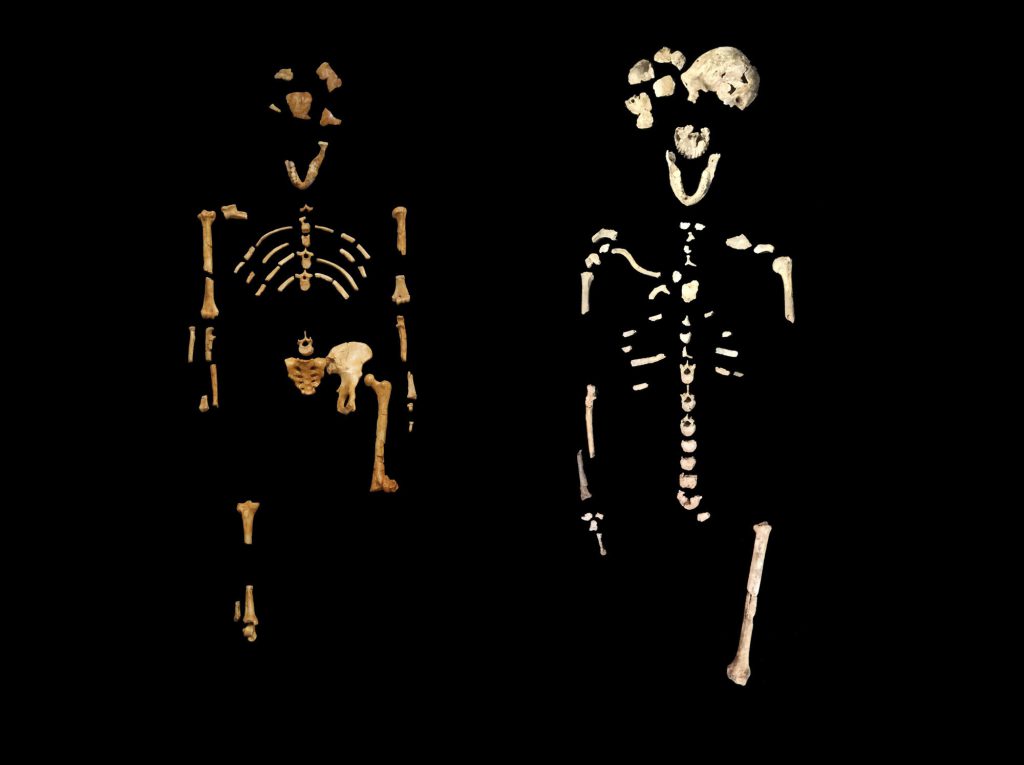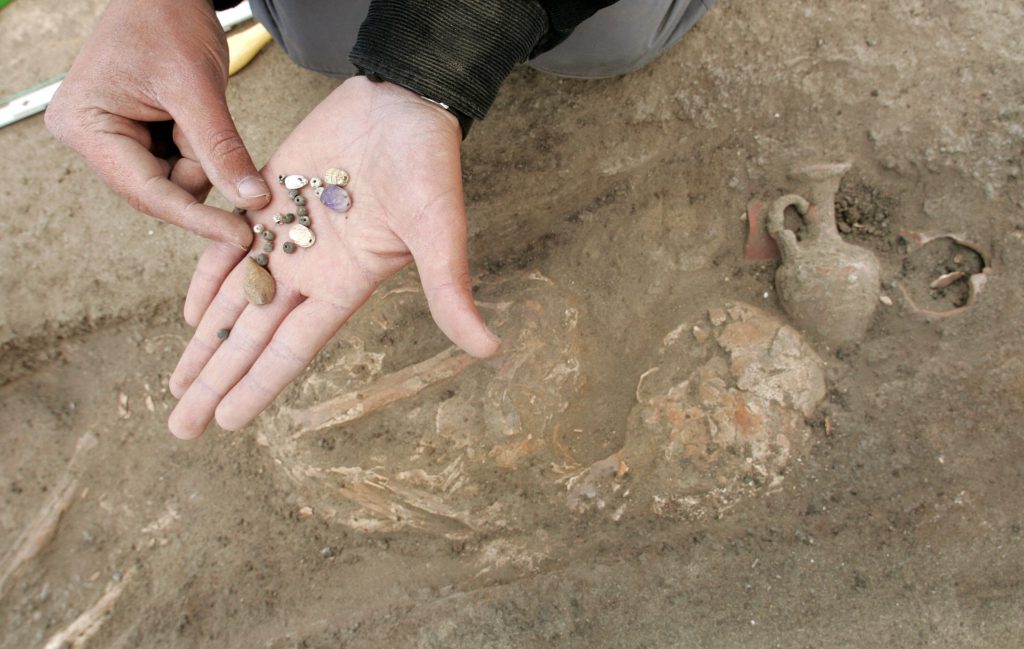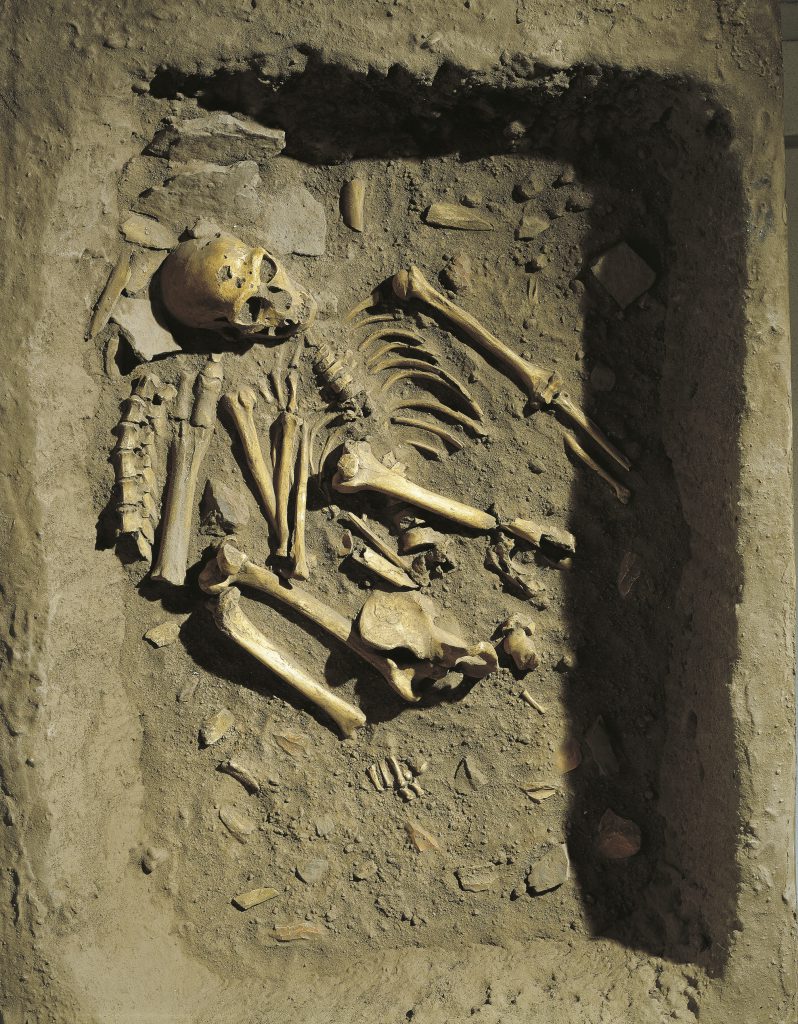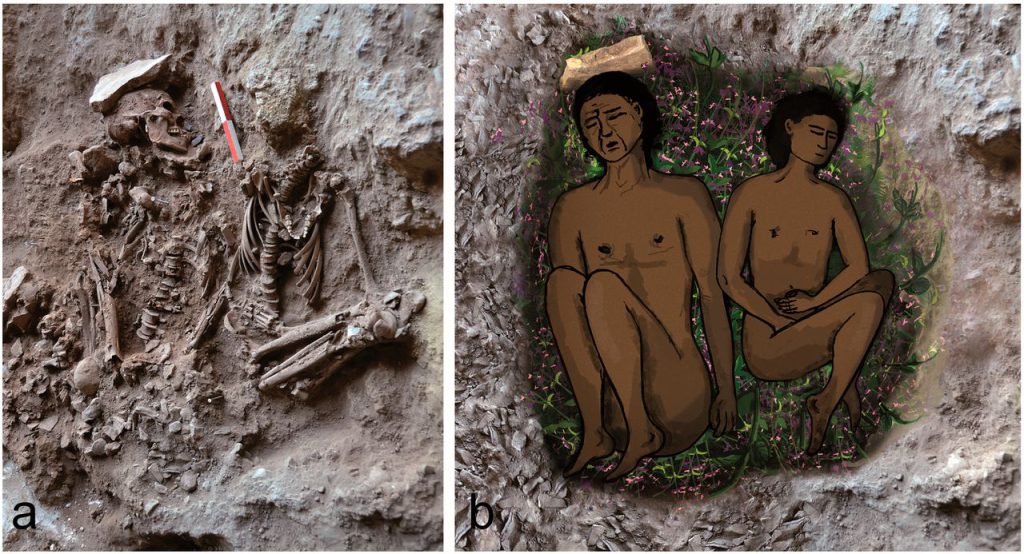Who First Buried the Dead?

This article was originally published at Aeon.
Please note that this article includes images of human remains.
A mysterious cache of bones, recovered from a deep chamber in a South African cave, is challenging long-held beliefs about how a group of bipedal apes developed into the abstract-thinking creatures that we call “human.” The fossils were discovered in 2013 and were quickly recognized as the remains of a new species unlike anything seen before. Named Homo naledi, it has an unexpected mix of modern features and primitive ones, including a fairly small brain. Arguably the most shocking aspect of Homo naledi, though, concerned not the remains themselves but rather their resting place.
The chamber where the bones were found is far from the cave entrance, accessible only through a narrow, difficult passage that is completely shrouded in darkness. Scientists believe the chamber has long been difficult to access, requiring a journey of vertical climbing, crawling, and tight squeezing through spaces only 20 centimeters across. It would be an impossible place to live, and a highly unlikely location for many individuals to have ended up by accident. Those details pushed the research team toward a shocking hypothesis: despite its puny brain, Homo naledi purposefully interred its dead. The cave chamber was a graveyard, they concluded.
For anthropologists, mortuary rituals carry an outsize importance in tracing the emergence of human uniqueness—especially the capacity to think symbolically. Symbolic thought gives us the ability to transcend the present, remember the past, and visualize the future. It allows us to imagine, to create, and to alter our environment in ways that have significant consequences for the planet. Use of language is the quintessential embodiment of such mental abstractions, but studying its history is difficult because language doesn’t fossilize. Burials do.
Burials provide a hard, material record of a behavior that is deeply spiritual and meaningful. It allows scientists to trace the emergence of beliefs, values, and other complex ideas that appear to be uniquely human. Homo sapiens is unquestionably unlike any other species alive today. Pinpointing what separates us from the rest of nature is surprisingly difficult, however.
The paradox is that humans are also unquestionably a part of nature, having evolved alongside all the rest of life. Anthropologists have narrowed in on one singular human feature in particular: the capacity to think in the abstract. Our ability to imagine and communicate ideas about things that are not immediately in front of us is a complex cognitive process, scientists argue, one that is remarkably different from simple, primitive communication about nearby food or imminent danger.
Humans use symbols to communicate and convey these abstract thoughts and ideas. We imbue nonpractical things with meaning. Art and jewellery, for example, communicate concepts about beliefs, values, and social status. Mortuary rituals, too, have been put forward as a key example of symbolic thought, with the idea that deliberate treatment of the dead represents a whole web of ideas. Mourning the dead involves remembering the past and imagining a future in which we too will die—abstractions believed to be complex enough to be contemplated only by our species.
The assumption, then, was that death rituals were practiced only by modern humans, or perhaps also by their very closest relatives. The possibility that primitive, small-brained Homo naledi could have engaged in the deliberate disposal of dead bodies not only challenges the timeline about when such behaviors appeared; it disrupts the whole conventional thinking about the distinction between modern humans and earlier species and, by extension, the distinction between us and the rest of nature.
For humans, death is an enormously culturally meaningful process. Cultures around the world honor the deceased with rituals and ceremonies that communicate a variety of values and abstract ideas. Since the 19th century, anthropologists have examined these mortuary practices to learn about the religions and beliefs of other cultures. During this time, it never occurred to anyone that other creatures, even other hominins (the primate group encompassing the genus Homo, along with the genus Australopithecus and other close relatives) could have engaged in similar behavior. Surely, the thinking went, humans alone operate in such an abstract world as to assign deep meaning to death.
Yet this behavior must have appeared at some point in our evolutionary history. Since mortuary rituals such as song and dance are invisible in the archaeological record, scientists focused on material aspects such as burial to trace the history of the practice. The discoveries soon prompted tough questions about the conventional viewpoint, suggesting that mortuary rituals might not have been uniquely human after all.
The first debate over nonhumans burying their dead arose in 1908 with the discovery of a fairly complete Neanderthal skeleton near La Chapelle-aux-Saints in France. After excavating their find, the discoverers argued that the skeleton had clearly been deliberately buried. To them, it looked as though a grave had been dug, the body purposefully laid inside in the fetal position, and safely covered up from the elements. Many contemporary scientists remained dubious of this interpretation or dismissed the evidence outright. Later skeptics suggested that early 20th-century excavation techniques were too sloppy to prove such a sweeping conclusion. Debate over the burial of the La Chapelle Neanderthal continues to this day.
It is fitting that the controversy over mortuary ritual in hominins began with the Neanderthals, now known as the species Homo neanderthalensis. Ever since the first discovery of Neanderthal fossils in 1856 in the Neander Valley in Germany, the species has occupied an ambiguous relationship to humans. Neanderthals are the closest species to humans, and their location on the spectrum between humans and other animals has constantly been contested.
For the first century after their discovery, they were typically imagined as highly nonhuman creatures, their primitive aspects emphasized to such an extent that they became known as brutes who couldn’t even stand up straight. More recently, the pendulum has swung the other way, with some scientists arguing that the creatures were so close to humans that a Neanderthal wearing a suit and a hat on a subway would go largely unnoticed. The debate over Neanderthal burials has similarly wavered back and forth. At some times, scientists have accused each other of overly anthropomorphizing our cousin species, at other times of dehumanizing them.
The collapse of the flower-burial hypothesis made scientists cautious to assert human beliefs based on fossil evidence.
A discovery in 1960 in Shanidar cave in Iraq illustrates the dangers involved in inferring Neanderthal behavior and in trying to understand their cognitive processes from sketchy remains. Excavators studying fossils at Shanidar uncovered evidence of multiple Neanderthal burials. One burial appeared particularly interesting: Soil samples from the area surrounding that individual, named Shanidar IV, revealed pockets of pollen. Ralph Solecki, the leader of the team and an anthropologist at Columbia University, viewed this pollen as evidence that colorful flowers were placed in the grave when the Neanderthal was buried, in a very modern human style.
In Solecki’s view, this “flower burial” suggested that Neanderthals had an appreciation of beauty—the first time such a sentiment had been found to extend beyond the boundary of our own species. He argued that scientists could no longer deny that Neanderthals experienced the “full range of human feelings.” But Solecki’s ideas collapsed when the pollen surrounding Shanidar IV was shown to have been transported by burrowing rodents, which disturbed the soil in distinctive patterns. The collapse of the flower-burial hypothesis caused scientists to be more cautious when asserting human beliefs based on limited fossil evidence—and perhaps on wish fulfillment. Looking back on the incident, later scientists remarked that it was probably no coincidence that the error occurred during the “great decade of flower power.”
Today, most scientists agree that Neanderthals did in fact bury their dead—at least some Neanderthals did, in at least a few instances. The more difficult question is, why did they do it? Did Neanderthals think about death in ways similar to modern humans, contemplating abstract thoughts such as the afterlife? Or was burial a practical solution to a decomposing corpse located in a living space?
Anthropologists agree that the current evidence linking Neanderthal burial to symbolic thought is shaky at best. There is little evidence of burial goods or other clear signs of ceremony included in Neanderthal graves, a practice seen more often with early Homo sapiens. Without clearly symbolic additions such as flowers or grave goods, it is difficult to get into the heads of these ancient hominins.
Then again, it isn’t so radical to imagine that Neanderthals had the capacity to bury their dead for the same reasons that we do. They had extremely large brains, well within the range of modern human brains; it’s conceivable that they were as cognitively and behaviorally complex as humans, too. Even if scientists were to admit Neanderthals within the group of species that practiced mortuary rituals, then, we could still maintain a uniqueness argument that only large-brained hominins performed this symbolic activity.
Homo naledi is a whole different story. Its brain was less than half the size of a modern human’s brain. One way to look at the puzzle is that naledi makes the connection between burial and symbolism increasingly dubious: It is easier to imagine that these creatures disposed of their dead for practical reasons than for symbolic ones. But why, then, would naledi go through all the effort of bringing the fossils through the darkness, so far into the cave? The evidence demands at least considering the other possibility, that these seemingly primitive creatures were in fact engaging in complex, deeply emotional behavior.
By challenging accepted ideas of symbolism and body disposal, naledi forces scientists to reconsider long-held assumptions and ideas about this behavior. Perhaps mortuary ritual is not as uniquely human as previously believed.
If Neanderthals and naledi are accepted into the club of hominins who practice mortuary rituals, it would not be the first time that a supposedly uniquely human behavior turned out to be shared with other species. Until the 1960s, toolmaking was widely considered something that only humans do. Then Jane Goodall witnessed chimpanzees modifying materials to make tools of their own. In response to the news, her mentor Louis Leakey telegraphed: “Now we must redefine tool, redefine Man, or accept chimpanzees as humans.”
Perhaps burial is yet another reminder that there is no sharp, impenetrable line between humans and other animals. Such blurring of boundaries is now well-recognized in anatomical evolution. In recent decades, scientists have become aware that distinctively “human” features actually appeared piecemeal, in unexpected patterns; upright posture and an increase in brain size, for instance, appeared in fits and starts, with some reversals along the way. Our ancestors appear to us as mosaics, containing some of these modern features while lacking others.
Maybe this mosaic progression applies to human behavior as well. Could it be that our culture—including abstract thinking and complex symbolic actions—arrived not in a single package, but rather evolved piecemeal?
This hypothesis leads to new questions about the emergence of human nature, and suggests new places to look for evidence. A growing number of anthropologists have begun to argue for a broad shift in the ways we think about change, innovation, and emergence throughout human evolution. They argue that, instead of conceptualizing human evolution in terms of extraordinary moments of origin and revolution, it is more productive to focus on gradual transitions. This shift in thinking regards incremental evolutionary processes as more significant than moments of sudden innovation.
The practice of defining uniquely human features is colored by value judgments about what matters to us.
The anthropologists pushing for this conceptualization argue that breaking processes such as the development of complex cognition and culture into their constituent parts opens up new opportunities to examine those parts in fine detail—an exercise more revealing than trying to understand the package in its entirety. The complex practice of mortuary ritual might be easier to understand if deconstructed into its constituent practices and cognitive processes. This idea dovetails with a recognition of the permeable boundary between human mortuary behavior and the behaviors of other hominins or even more distantly related species. It could ultimately allow for more detailed cross-genera comparisons, leading to a better understanding of those other species, as well as of ourselves.
The recognition that human culture might have emerged gradually, through starts and stops, exposes a common but poorly founded assumption that major developments happen in bundles. Without any evidence to the contrary, it was easy to default to the notion that major human transitions occurred simultaneously—that we emerged as our modern selves through a kind of evolutionary genesis. Charles Darwin fell into this trap, assuming that bipedalism evolved alongside the increase in brain size and the simultaneous freeing of the hands for tool use. But as more evidence has accrued, the picture has become more complicated and difficult to fit in a tidy narrative. The discovery of australopithecines and other fossil hominins made it clear that these processes happened at different stages in human evolution.
If Homo naledi truly did engage in symbolic behavior, that would raise an even more sweeping question: Should scientists disregard the idea of human uniqueness altogether? Some scholars have been making that argument for decades, suggesting that searching for unique traits detracts from the more useful endeavor of pinpointing smaller transitions and recognizing differences of degree rather than kind. They also caution that the practice of defining uniquely human features is colored by value judgments about what matters to us in the present. In Beast and Man (1979), the moral philosopher Mary Midgley argued: “If man wants to set up a contest in resembling himself and award himself the prize, no one will quarrel with him. But what does it mean? All he can do by these roundabout methods is perhaps to assert a value-judgment about what matters most in human life.”
Understanding humans’ evolutionary history is a daunting task. It is a subject that is deeply personal to us, and we anthropologists have often been accused of standing too close to our family tree to be able to see the larger picture. From that vantage, it is all too easy to view the evolution into Homo sapiens as distinct from the evolution of other creatures. Recognizing a mosaic aspect to human behavior has the potential to alter that perspective.
By letting go of the belief in the uniqueness of our behavior, we might be able to see how our tendency to view ourselves as terribly special alienates us from the rest of our primate family, and indeed from all of evolution. Writing in The New York Times in 2015, the primatologist Frans de Waal argues that the discovery of Homo naledi is an opportunity to rethink that fractured relationship between humans and the rest of nature: “Why not seize this moment to overcome our anthropocentrism and recognize the fuzziness of the distinctions?”


































